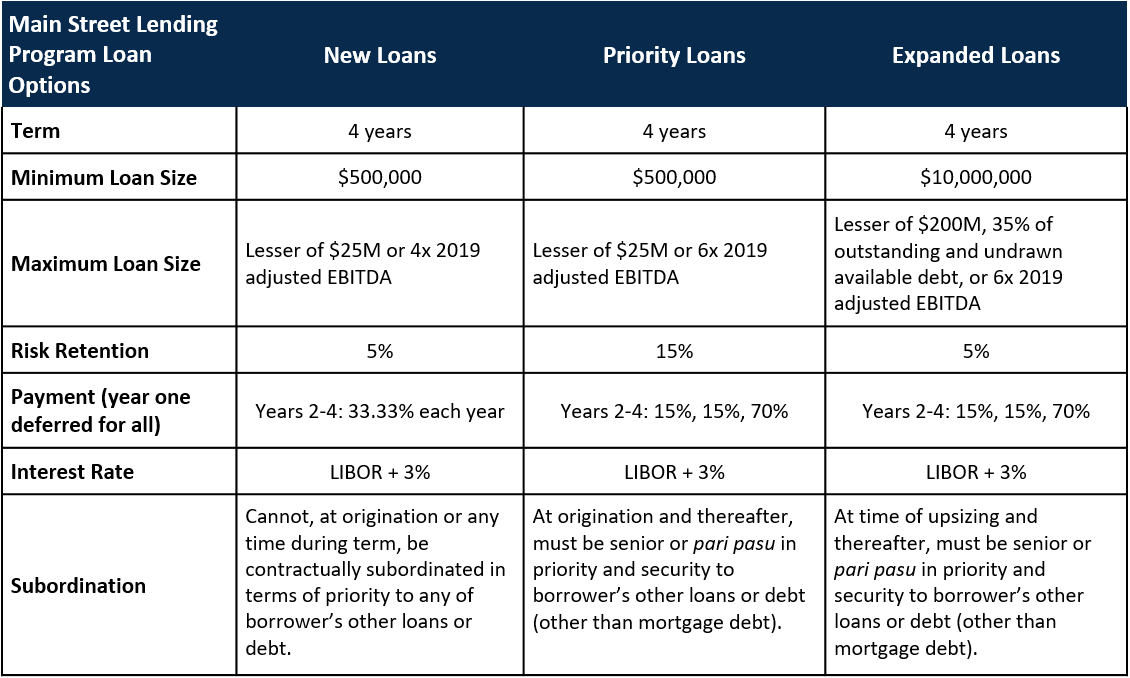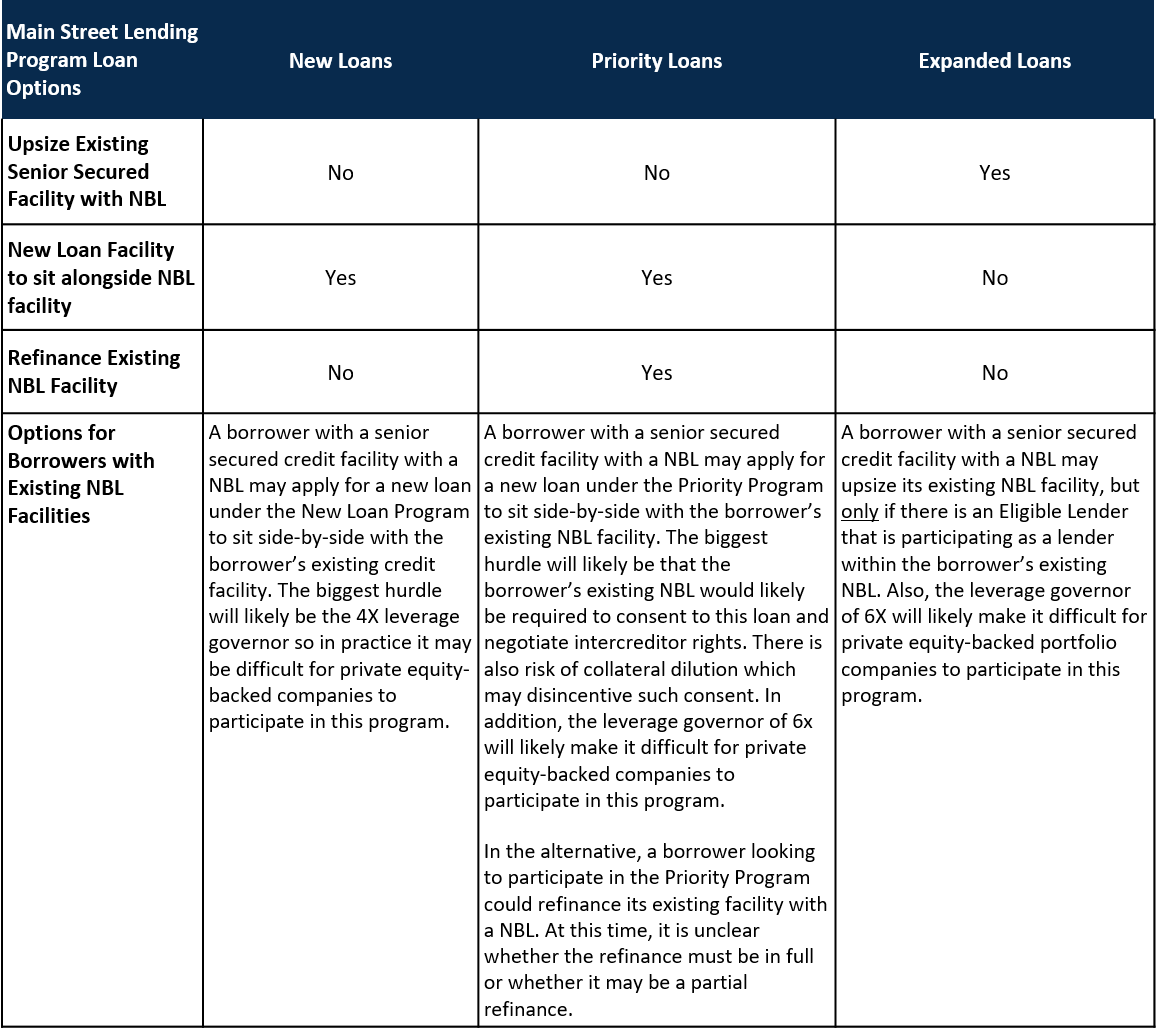Insights
Fed Expands and Releases New Details of Main Street Lending Program
On April 30, 2020, the U.S. Federal Reserve published an FAQ and revised term sheets with new details regarding the Main Street Lending Program, including expanded eligibility for program loans and a new loan category. The Main Street Lending Program provides Fed financing to lenders that in turn make loans to businesses, either in the form of new loans or increases to existing loan facilities (“expanded loans”). This latest update establishes a third option, which is intended for borrowers with greater leverage; dubbed “priority loans” by the Fed, these are new loans with increased risk sharing by lenders. While there is still no launch date for the program, interested businesses should talk to their lenders now to see if they plan to participate in the Main Street program.
For private equity sponsors, the Main Street Lending Program may offer another lifeline for portfolio companies impacted by the COVID-19 pandemic. However, in deciding whether to participate, sponsors should be mindful of the program eligibility requirements (including affiliation rules), the restrictions imposed on borrowers and implications of planned public disclosures regarding Main Street loans.
Key Loan Terms
The chart below summarizes the key terms of new loans, priority loans and expanded loans, including expanded eligibility1 for the original two loan options. Importantly, unlike loans guaranteed by the Small Business Administration (“SBA”) under the Paycheck Protection Program (“PPP”), Main Street loans are not forgivable.

Who is Eligible for a Main Street loan?
Main Street loans are available to U.S. businesses established prior to March 13, 2020 that either have 15,000 or fewer employees, or have 2019 annual revenues of $5 billion or less. Businesses must also have significant operations and a majority of employees based in the United States. The business must have been in “sound financial condition” prior to the COVID-19 pandemic and must certify that it reasonably believes it can meet its financial obligations for at least 90 days and does not expect to file for bankruptcy during that time. Lenders are expected to conduct their own underwriting of applicants, and may have additional requirements on top of the Fed’s eligibility requirements. As such, a business that otherwise meets all of the eligibility requirements for a Main Street loan may nonetheless be unable to obtain financing under the program due to the lender’s discretion.
To determine a borrower’s employee count and revenue, the Fed will apply the SBA’s affiliation rules under 13 CFR 121.301(f). While these are the same rules applied to PPP borrowers, unlike the PPP, there are no exemptions for hospitality businesses, franchises or businesses receiving financial assistance from a small business investment company. Potential borrowers (particularly private fund portfolio companies) should use caution because, as is the case with the PPP, even a minority investor could be treated as an affiliate for purposes of determining eligibility, depending on the investor’s ability to block action of the borrower’s board or to block certain operational decisions.2
A business’s employee number is determined based on the total number of persons employed by the business and its affiliates for each pay period over the 12 months prior to the Main Street loan’s origination or upsizing of an existing loan. For this purpose, “employees” include all full-time, part-time, seasonal, or otherwise employed persons of the business and its affiliates, excluding volunteers and independent contractors. Revenue is determined based on the business’s 2019 GAAP revenue as set out in its audited financial statements or its annual receipts as reported to the IRS.
Borrowers that have an outstanding PPP loan may participate in the Main Street Lending Program. It is unclear whether the outstanding balance of a PPP loan will be included with the borrower’s other outstanding debt for purposes of calculating its maximum Main Street loan size (as some or all of a PPP loan may be forgiven), but in the absence of express guidance from the Fed, the rules suggest PPP loans would be counted like other debt.
In practice, it may be difficult for private equity portfolio companies to access Main Street loans given the debt limits imposed by the program and, in some cases, consent rights of existing senior lenders with respect to new debt.
How Main Street Loan Programs May be Utilized by Borrowers That Have Credit Facilities with Non-Eligible Lenders (i.e., non-bank lenders, direct lenders, or other ineligible financial institutions)
On the lender side, only certain U.S. banking entities may participate as “Eligible Lenders”, though the Fed is considering options to expand the list of Eligible Lenders, potentially to include certain non-bank lenders (“NBLs”). The result is that borrowers seeking to upsize a loan through the expanded loan program must have at least one Eligible Lender in their existing lending syndicate. For now, loans made solely by NBLs are not eligible to be upsized. If they are otherwise eligible, borrowers with only NBLs in their debt structure can still seek new financing under the new loan or priority loan options, or can seek to refinance NBL debt with the priority loan option, but any Main Street loans must be originated by an Eligible Lender.
The below chart summarizes the key features of each of the three Main Street loan programs for consideration by borrowers that have only NBLs in their debt structure:

Key Borrower Obligations and Restrictions
As with other federal stimulus programs, Main Street loans come with strings attached for borrowers:
- Maintaining Employees: The Fed clarified that its term sheets’ reference to using “commercially reasonable efforts” to maintain employees means that a borrower must make good-faith efforts to maintain its payroll and retain employees, in light of its capacities, the economic environment, its available resources, and the business need for labor. The Fed also clarified that businesses that have already laid-off or furloughed workers as a result of the disruptions from COVID-19 are eligible to apply for Main Street loans.
- Dividends, Buy-backs, Executive Comp: The Fed reiterated that borrowers will face restrictions on dividends, distributions, repurchases of publicly traded securities, payments to highly compensated executives, and certain labor matters. However, the FAQ excludes from such limits “distributions made by an S corporation or other tax pass-through entity to the extent reasonably required to cover its owners’ tax obligations in respect of the entity’s earnings.”
- Existing Debt: Only mandatory payments of principal or interest on other debt are permitted until a Main Street loan is repaid, meaning borrowers will not be able to cancel or reduce any committed lines of credit. This limitation applies to all three loan options, but borrowers of priority loans may refinance existing debt owed to a lender that is not an Eligible Lender at the time a Main Street loan is originated. Per the Fed’s guidance, these limits won’t prohibit a borrower from repaying a line of credit in the normal course, incurring equipment financing or similar debt in the ordinary course (so long as it is secured by newly acquired property and is otherwise lower priority), and refinancing maturing debt.
- Other Requirements: The CARES Act contemplates additional borrower restrictions that may apply when the Fed is a direct lender; to date, guidance on the Main Street program has not clarified whether the Fed will apply any of these requirements to Main Street loans.
Will Borrower Information Become Public?
Yes. The Fed expects to publicly disclose, among other things, the names of lenders and borrowers, amounts borrowed and interest rates charged, overall costs, revenues and other fees will be disclosed.
Businesses considering a Main Street loan should be mindful of these disclosures and the scrutiny that may follow from policy makers and the press, as with recent criticism of public companies receiving PPP loans.
1 Under the latest terms, businesses with up to 15,000 employees (up from 10,000) or up to $5 billion in annual revenue (up from $2.5 billion) are now eligible. The minimum loan size for two of the options was also lowered to $500,000 from $1 million.
2 For background on the PPP affiliation rules, see Choate’s prior alerts: Treasury Department Finally Issues Affiliation Guidance for Paycheck Protection Program and COVID-19 Stimulus Loans: Are PE and VC Portfolio Companies Eligible?